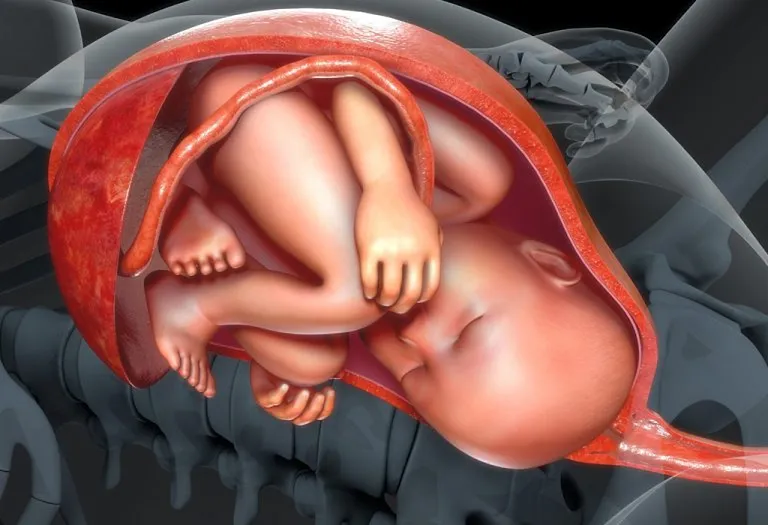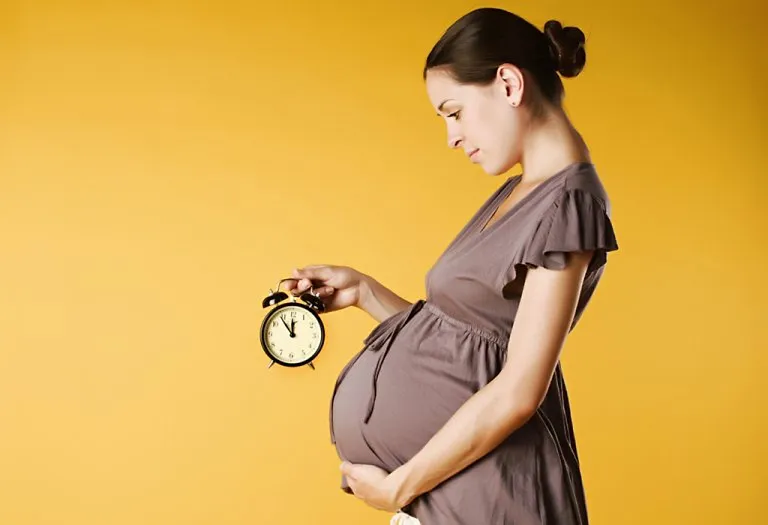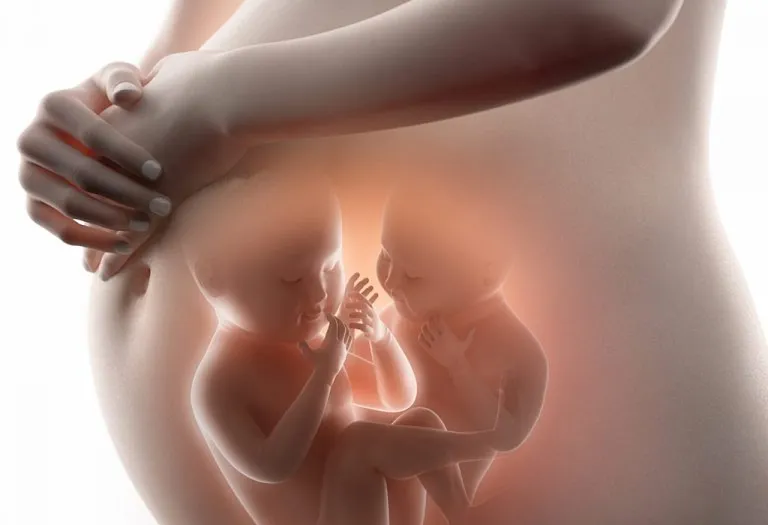Placenta in Pregnancy – Functions and Complications

- What Is Placenta?
- How Does the Placenta Develop?
- Importance of the Placenta
- Types of Placenta in Pregnancy
- Functions of the Placenta During Pregnancy
- Factors That Affect the Functioning of the Placenta
- Placental Complications During Pregnancy
- Signs and Symptoms of Placental Problems
- Is It Possible to Reduce the Risk of Placental Problems?
- How Does Placenta Work in Twin and Multiples Pregnancies?
- FAQs
The placenta is an important organ that develops in the uterus during pregnancy to provide oxygen and nutrients to the baby, and to remove waste products from the baby’s blood. It’s a flattened, circular organ that gets attached to the wall of the uterus. It provides for all the nutritional needs of the baby and carries out various other functions for the growing foetus. The placenta is attached to the baby by the umbilical cord. Commonly, the placenta attaches to the side or the top of the uterus, but in rare cases, it might attach itself to the lower area of the uterus. It’s called a low-lying placenta. The placenta is delivered soon after the birth of the baby. Understanding the placenta position in pregnancy is crucial, as it can impact both maternal and fetal health, influencing delivery plans and potential complications.
If you’re pregnant, read on to learn more about the placenta and its importance and functions during pregnancy.
What Is Placenta?
The placenta is an organ that develops in the uterus during pregnancy. It plays a crucial role in providing oxygen and nutrients to the growing baby while also removing waste products from the baby’s blood. The placenta is attached to the wall of the uterus and is connected to the baby via the umbilical cord. It also produces hormones that help maintain the pregnancy and support fetal development (1).
Placenta means “a flat cake” in Latin, referring to its shape. After the baby is born, the placenta is expelled from the uterus in a process called the afterbirth.
How Does the Placenta Develop?
The placenta begins to form soon after conception, usually within 7 to 10 days. Initially composed of just a few cells, it grows into a disc-shaped organ roughly 10 inches in length and 1 inch in thickness, with a textured surface. By 18 to 20 weeks of pregnancy, it reaches a weight of approximately 16 ounces. By the 12th week, the placenta becomes fully functional and takes over the responsibility of producing essential hormones.
Importance of the Placenta
The placenta is the support system of the unborn child. The nutrients and oxygen from the mother reach the placenta through the bloodstream. The umbilical cord attached to the placenta carries it to the foetus (2). In a similar way, the umbilical cord carries the waste products from the baby into the placenta and thus to the mother’s bloodstream for the final disposal. Apart from nurturing the foetus, the placenta also protects the foetus from any kind of bacterial or viral infection.
Types of Placenta in Pregnancy
The placenta is a vital organ that supports the developing fetus during pregnancy, but not all placentas are the same. Depending on its structure, location, and attachment, the placenta can vary in type. Below are four common types of placenta observed during pregnancy (3):
1. Posterior Placenta
A posterior placenta develops on the back wall of the uterus, closest to the spine. This position is considered common and is often associated with earlier detection of fetal movements, as the placenta is not cushioning the front of the abdomen. It typically does not interfere with delivery and is generally seen as a favorable position.
2. Anterior Placenta
An anterior placenta grows on the front wall of the uterus, closest to the abdomen. This position is also common but may cause a slight delay in feeling fetal movements because the placenta acts as a cushion between the baby and the mother’s abdominal wall. While it usually doesn’t affect delivery, it can make certain prenatal tests, like amniocentesis, slightly more challenging.
3. Fundal Placenta
A fundal placenta is located at the top (fundus) of the uterus. This position is considered normal and is often seen in many pregnancies. It allows for optimal blood flow to the placenta and is unlikely to cause complications during pregnancy or delivery. However, if the placenta extends too far downward, it may lead to a low-lying placenta or placenta previa.
4. Lateral Placenta
A lateral placenta develops on either the right or left side of the uterus. This position is less common but is generally not a cause for concern. It may slightly affect how the baby’s movements are felt, depending on which side the placenta is located. Like other placental positions, it typically does not interfere with delivery unless it is low-lying or associated with other complications.
Functions of the Placenta During Pregnancy
How does the placenta work? The placenta performs many important functions from the conception to the birth of the child. Discussed here are details about the placenta and its function (4).
- The placenta carries nutrients from the mother’s bloodstream to the foetus, thus providing it with all the basic nutrients.
- The placenta carries oxygen to the baby.
- The placenta purifies the blood of any harmful substance, which might harm the foetal health, by acting as a barrier and providing protection against it.
- Protein in the mother’s blood is digested in the placenta before entering the foetal bloodstream.
- The placenta acts as the baby’s liver before the foetal liver is formed, to store glycogen, fat, etc.
- The placenta acts as an endocrine gland by secreting hormones such as progesterone, oestrogen, and HCG (human chorionic gonadotropin).
- Nitrogenous waste from the foetus passes through the placenta before entering into the mother’s bloodstream.
- The placenta also breaks down the food particles consumed by the mother for the easy absorption of nutrients by the foetus.
- Vast amounts of hormones are secreted to produce placental lactose. It ensures good levels of glucose in the mother’s bloodstream which in turn will be circulated in the baby’s system.
- One of the vital functions of the placenta is to aid the oxygen inhaled by the mother to reach the baby. It also prevents the possibility of inhalation of amniotic fluids by the baby, which may prove to be fatal.
- During the later stages of pregnancy, the placenta moves on top of the womb for easy opening of the cervix and delivery of the baby.
- The placenta produces various hormones to keep premature contractions of the uterus at bay.
Factors That Affect the Functioning of the Placenta
A healthy placenta is very important for the growth and development of the foetus. Although in most cases the placenta keeps performing all the functions without any complications, there are a few factors that might disrupt the proper functioning of this organ, giving rise to a placenta problem pregnancy.
1. Maternal Age
Women who are 40 years of age or above are more likely to have complications and may face placental problems (5).
2. Trauma
Any kind of trauma to the abdominal region of a pregnant woman may prove to be fatal and cause serious issues with the placenta as well (6).
3. High Blood Pressure
Blood pressure which is above the normal levels is likely to be harmful to the placenta and may cause a threat to foetal health.
4. Carrying Twins or More Babies
A woman who is pregnant with twins or more babies are at a probable danger of having complications with their placenta (7).
5. Blood-Clotting Problems
Placental problems may arise in mothers who have a medical history that hinders their blood to clot.
6. Premature Membrane Rupture
The amniotic sac provides cushioning to the baby. But if it ruptures before the labour, it is likely to cause problems to the placenta (8).
7. Consuming Harmful Substances
Use of certain medicines, drugs, etc., can cause a serious threat to the placenta which in turn can cause various complications.
8. Previous Placental Problem
Women who have had issues related to the placenta in their earlier pregnancies are at an increased risk of having them in their subsequent pregnancies as well.
9. Previous History of Uterine Surgery
Women who have undergone surgical procedures in their uterine region are more susceptible to having placenta-related problems (9).
10. Gestational Diabetes
Women who develop gestational diabetes during pregnancy are at a major risk of developing issues related to the placenta.

Placental Complications During Pregnancy
It is very important to keep a check on placental health throughout the pregnancy for healthy foetal development. Normally, there are no complications with the placenta, but in a few cases, placental problems may arise due to a number of reasons in pregnancy. Here are some of the placenta issues during pregnancy.
1. Placenta Previa or Low-Lying Placenta
The placenta is usually located on the side or on the top of the uterus. But when the placenta is unusually low in the uterus, either covering the cervix or next to it, this condition is called placenta praevia. In the later stages of pregnancy, placenta praevia may cause serious complications. In case of complete or total praevia, the placenta is covering the cervix completely. In such cases, the baby cannot be born through vaginal delivery and a caesarean section will need to be performed. In the case of partial praevia, there are still chances of vaginal birth. This condition is common in older women, women who have had uterine surgeries, women who have undergone caesarean section before, and women who have had abortions, etc.
2. Placental Dysfunction
The main function of the placenta is to provide sufficient nutrition to the foetus. Placental insufficiency occurs when the placenta is unable to provide enough nutrients to the foetus. This condition can pose a serious threat to the unborn child, such as oxygen deprivation at birth, premature labour, stillbirth, etc. Though this condition may not be life-threatening for the woman, it might become dangerous for her in cases where she suffers from hypertension or diabetes.
3. Abruption of Placenta
Placental abruption is said to occur when the placenta detaches from the uterus during the course of pregnancy. The detached blood vessels cause vaginal bleeding, pain in the stomach, and contractions. This condition might affect the growth of the foetus, cause premature birth or even lead to stillbirth. Women with medical conditions such as hypertension and diabetes, uterine complications, abdominal trauma, and previous history of abruption, and women who smoke or use drugs are more likely to be at risk of having placental abruption during their pregnancy.
4. Hypertension
High blood pressure may cause problems in the placenta. The blood flow to the placenta decreases because of hypertension, which means fewer nutrients and oxygen get supplied to the foetus. This can result in slow growth, premature birth or low birth weight.
5. Placenta Accreta
When the placenta is too deeply attached to the uterine wall, the condition is called placenta accreta. This condition may cause premature birth. This kind of placenta has difficulty detaching from the uterine wall. Surgical or manual removal may cause serious haemorrhaging and can prove to be life-threatening.
6. Infarcts in the Placenta
Infarcts or dead tissues present in the placenta can disrupt the blood flow to the foetus. Though in a majority of the cases, these minor infractions do not pose any threat to the mother or the unborn child, serious infractions can cause foetal distress and other complications.
7. Retained Placenta
The placenta is usually delivered after the delivery of the child. But sometimes some part or parts of the placenta may remain inside the womb and may cause serious complications. If natural methods fail, then surgical intervention might be needed to remove the retained placenta.
Signs and Symptoms of Placental Problems
The placenta plays a critical role in supporting the developing fetus during pregnancy, but sometimes, issues can arise that affect its function. Below are some common signs and symptoms of placental problems:
- One of the most noticeable signs of placental issues, such as placental abruption or placenta previa, is vaginal bleeding. This can range from light spotting to heavy bleeding and requires immediate medical evaluation.
- Severe or persistent abdominal pain, especially if accompanied by tenderness, may indicate placental abruption, where the placenta separates from the uterine wall prematurely.
- A noticeable reduction in the baby’s movements can signal placental insufficiency, where the placenta isn’t delivering enough oxygen and nutrients to the fetus.
- High blood pressure, swelling, and protein in the urine are symptoms of preeclampsia, a condition that can affect placental function and lead to complications.
- Frequent or irregular contractions before the due date may be linked to placental problems, such as placental insufficiency or abruption.
Is It Possible to Reduce the Risk of Placental Problems?
While not all placental problems can be prevented, certain steps can help reduce the risk and promote a healthier pregnancy. Here are some practical ways to minimize the risk of placental problems:
- Attend Regular Prenatal Checkups: Routine prenatal visits allow healthcare providers to monitor the health of both the mother and the baby, detect potential issues early, and provide timely interventions if needed.
- Maintain a Healthy Diet: Eating a balanced diet rich in vitamins, minerals, and nutrients supports overall placental health and fetal development. Adequate intake of folic acid, iron, and calcium is particularly important.
- Avoid Smoking, Alcohol, and Drugs: These substances can impair placental function and increase the risk of complications such as placental abruption or low birth weight.
- Manage Chronic Conditions: Controlling pre-existing conditions like diabetes, high blood pressure, or autoimmune disorders can help reduce the risk of placental problems.
- Stay Active and Manage Stress: Moderate exercise and stress-reduction techniques, such as yoga or meditation, can improve circulation and overall well-being, supporting a healthy pregnancy.
How Does Placenta Work in Twin and Multiples Pregnancies?
Fraternal twins, as well as other multiple pregnancies resulting from more than one egg, develop when separate eggs are fertilised by different sperm. When it comes to placenta for twins, each baby typically has its own placenta, allowing them to grow independently with their own supply of oxygen and nutrients. This type of pregnancy is known as dichorionic-diamniotic, meaning each fetus has its own placenta (chorion) and amniotic sac.
On the other hand, identical twins or multiples originate from a single fertilized egg that splits into two or more embryos. Depending on when the split occurs, the babies may either share a single placenta or have separate placentas. In pregnancies with twins, one placenta, and two sacs, known as monochorionic-diamniotic twins, close monitoring is essential to detect and manage potential complications like twin-to-twin transfusion syndrome (TTTS) (10).
FAQs
1. Can the placenta be too large or too small?
Yes, an abnormally large placenta (placentomegaly) or a small placenta can indicate underlying issues. A large placenta may be linked to infections or gestational diabetes, while a small placenta might suggest placental insufficiency, affecting fetal growth.
2. Can the placenta attach to scar tissue from a previous c-section?
Yes, in some cases, the placenta can attach to scar tissue from a previous cesarean section, leading to a condition called placenta accreta. This can cause complications during delivery, such as severe bleeding, and often requires specialised care.
3. Can the placenta regrow if damaged?
The placenta cannot fully regrow if damaged, but it has some ability to compensate for minor issues by expanding its healthy areas. However, significant damage often requires medical intervention to ensure the baby’s well-being.
4. What is a placental lake?
Placental lakes are pools of blood visible on ultrasound within the placenta. While they are usually harmless, large or numerous lakes may sometimes be associated with complications like fetal growth restriction.
This was all about placenta and pregnancy. Bringing a new life into this world is an amazing feeling. Each woman undergoes a different journey and has a different experience. From the moment a child is conceived till the birth of the child, a woman needs to take care of her health, and otherwise too. During prenatal checkups, doctors often assess the placenta position in ultrasound to ensure it is properly located and to identify any potential risks, such as placenta previa or low placenta in pregnancy. Make sure you observe proper care and caution and discuss with your doctor in case you experience any complications during pregnancy.
References/Resources:
1. National Library of Medicine – Embryology, Placenta
2. National Library of Medicine – Placental Blood Circulation
3. Cleveland Clinic – Placenta
4. National Library of Medicine – The placenta: a multifaceted, transient organ
5. Texas Children’s Hospital – Advanced Maternal Age
6. National Library of Medicine – Abdominal trauma during pregnancy
7. University of Rochester Medical Center – Understanding Risks of a Multiple Pregnancy
10. Pregnancy, Birth, & Baby – About the placenta
Also Read:
Circumvallate Placenta
Calcification of Placenta in Pregnancy
Placental Lakes – Do They Affect Pregnancy?
Common Positions of the Placenta in Pregnancy
Was This Article Helpful?
Parenting is a huge responsibility, for you as a caregiver, but also for us as a parenting content platform. We understand that and take our responsibility of creating credible content seriously. FirstCry Parenting articles are written and published only after extensive research using factually sound references to deliver quality content that is accurate, validated by experts, and completely reliable. To understand how we go about creating content that is credible, read our editorial policy here.
























